Or search by topic
Number and algebra
Geometry and measure
Probability and statistics
Working mathematically
Advanced mathematics
For younger learners
Digital Equation



- Problem
- Getting Started
- Student Solutions
- Teachers' Resources
Let $k$ be an integer satisfying $0\le k \le 9\,$. Show that $0\le 10k-k^2\le 25$.
Mal from Bedford School in the UK and Mahdi from Mahatma Gandhi International School in India tried all the possible values of $k.$ Here is Mal's work:

Nikita from Jersey College for Girls, Mohamed S from LAE Tottenham in the UK and Sanika from PSBBMS, OMR in India used a graph. The sketch is from Nikita's work. This is how Sanika found the roots and the maximum value:
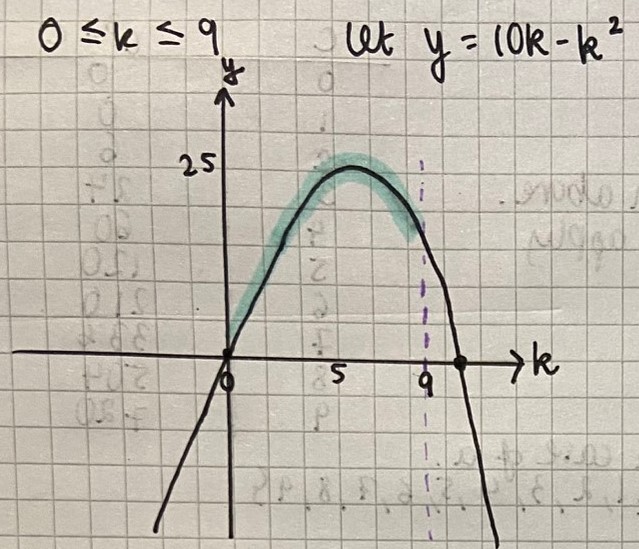 $y=f(x)=x(10-x)$
$y=f(x)=x(10-x)$
The roots of the equation are 0 and 10.
Since the squared term has a negative coefficient the parabola will face downwards.
The highest y-coordinate will therefore be in the first quadrant with an x value right between the two x intercepts. (As quadratic equations have symmetric graphs). This implies that the x coordinate is (0+10)$\div$2 = 5.
Substituting this value into the function $f(x)$ will give us the y coordinate; this will be the highest output of the function.
$\therefore 25\geq k(10-k)$
If the condition that $0\leq k\leq9$ is considered, then it can be concluded that the lowest y-coordinate is obtained when the x-coordinate is $0$ $\therefore 0\leq k(10-k)$
Nikita found the maximum value by completing the square:
$y=-(k-5)^2+25$
so max point is at $(5,25)$
Mohamed S found the maximum value using differentiation:
$f'(k) = 10-2k$
To find maximum:
$10-2k=0$
$10=2k$
$k=5$
$10\times5 - 5^2 = 25$
$25$ is the maximum
Wiktor from LAE Tottenham and David from the UK proved the inequality algebraically. This is David's work:
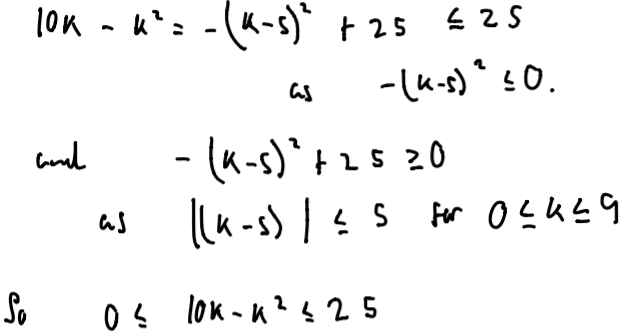
Sanika also proved the inequality using the arithmetic mean - geometric mean inequality:
AM-GM inequality: $\dfrac{a+b}2 \geq \sqrt{ab}$
Applying AM-GM to the numbers $k$ and $(10-k)$ we get the following: $$\frac{k+(10-k)}2 \geq \sqrt{k(10-k)} \Rightarrow 25\geq k(10-k)$$The expression will always give a positive integer as output if $0\lt k \leq 9\,.$ So the lowest value can be obtained when $k=0\, .$
Show also that $k(k-1)(k+1)$ is divisible by $3\,$.
Mal checked this for the integers 1 to 9:
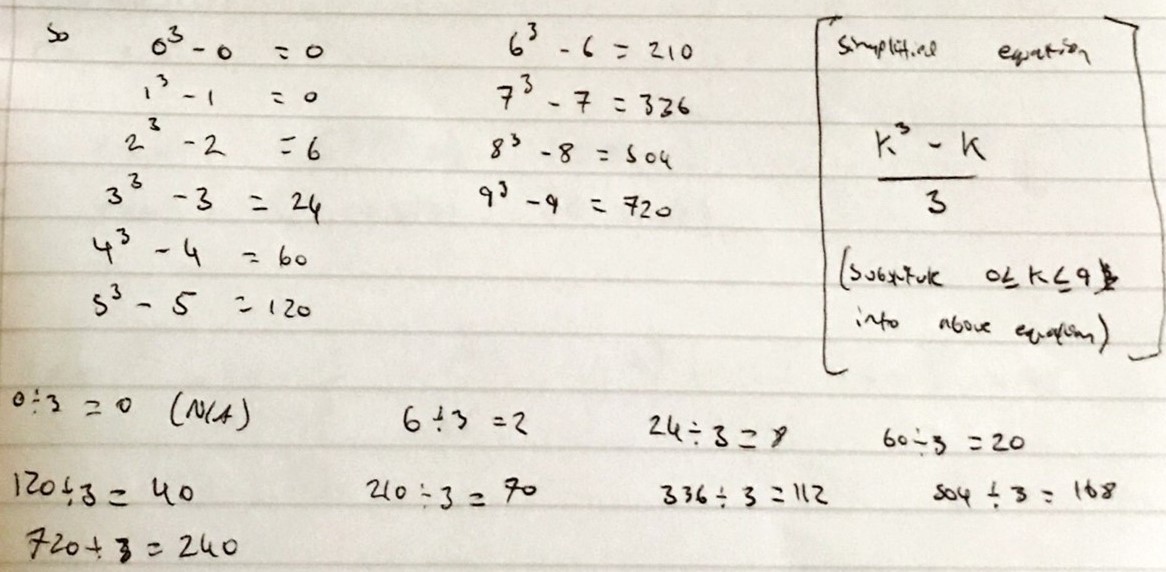
David, Wiktor, Mohamed S, Mahdi and Nikita wrote this simple proof (this is Wiktor's work):
Nikita and Sanika considered different cases. This is Nikita's work:
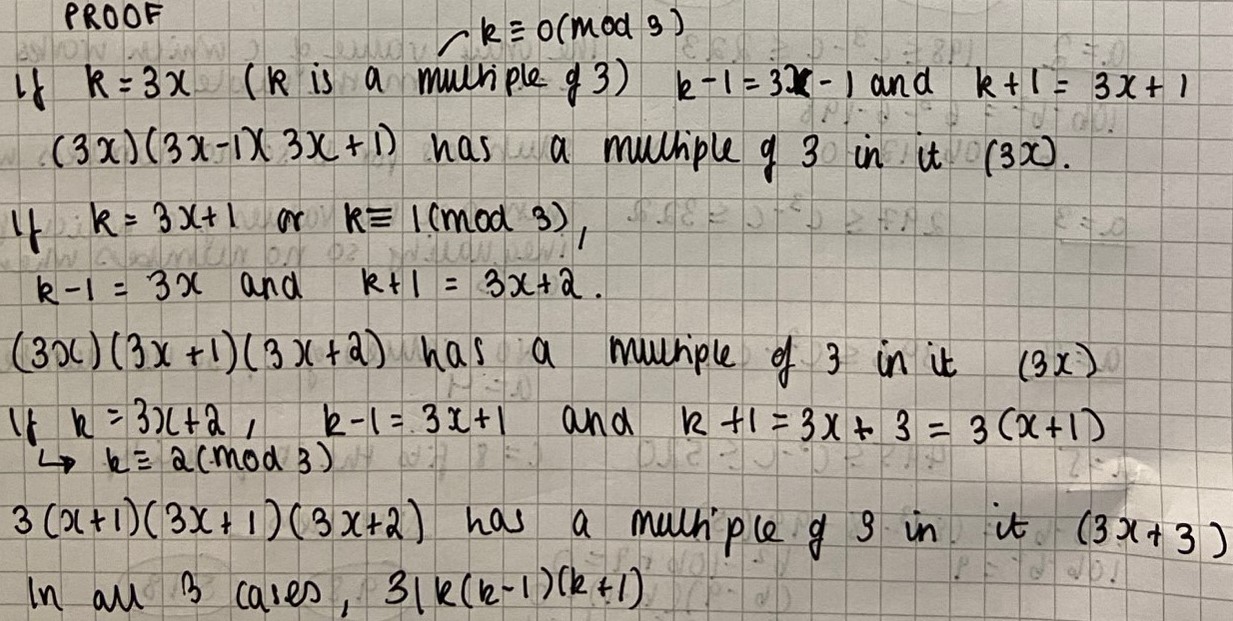
For each $3$-digit number $N$, where $N\ge100$, let $S$ be the sum of the hundreds digit, the square of the tens digit and the cube of the units digit. Find the numbers $N$ such that $S=N$.
Nikita, David, Mal, Wiktor, Mohamed S, Sanika and Mahdi found an equation linking $a,b$ and $c\,.$ This is Nikita's work:
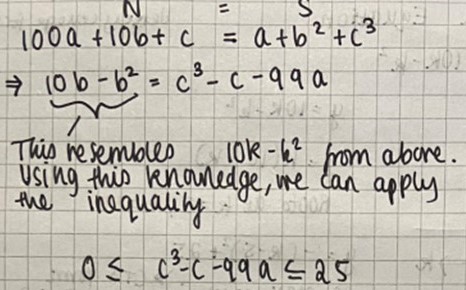
Nikita then found the possible values of $c^3-c$ and went through the values of $a$ to find solutions.
Wiktor and David used part 1 to find out more about $b$. This is Wiktor's work:
Mohamed wrote:
This means that a multiple of $99$ minus a number between $0$ and $25$ must be equal to $c(c+1)(c-1).$ $99a$ must be close to $c(c+1)(c-1)$ but smaller.
Mahdi, Mohamed, Wiktor and Mal used this idea to go through the possible values of $c$. This is Mahdi's work:
Using all the information, Sanika made a table showing the possible values of $a, b$ and $c$:
|
All possible values of: |
All possible values of: |
All possible values of: |
|||
|
$99a$ |
$a$ |
$b(10-b)$ |
$b$ |
$c(c-1)(c+1)$ |
$c$ |
|
99 |
1 |
0 |
0 or 10 |
120 |
5 |
|
198 |
2 |
9 |
1 or 9 |
210 |
6 |
|
297 |
3 |
21 |
3 or7 |
336 |
7 |
|
396 |
4 |
24 |
4 or6 |
504 |
8 |
|
495 |
5 |
|
|
720 |
9 |
|
594 |
6 |
|
|
|
|
|
693 |
7 |
|
|
|
|
After a couple of combinations, 4 numbers can be derived:
175
135
518
598
You may also like
Curvy Equation
This problem asks you to use your curve sketching knowledge to find all the solutions to an equation.
Euler's Totient Function
How many numbers are there less than $n$ which have no common factors with $n$?
Frosty the Snowman
Frosty the Snowman is melting. Can you use your knowledge of differential equations to find out how his volume changes as he shrinks?

